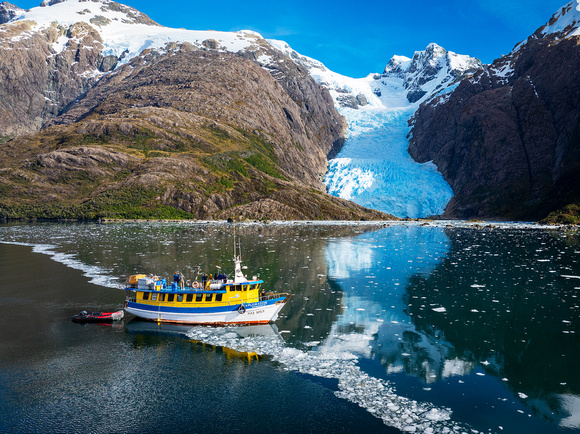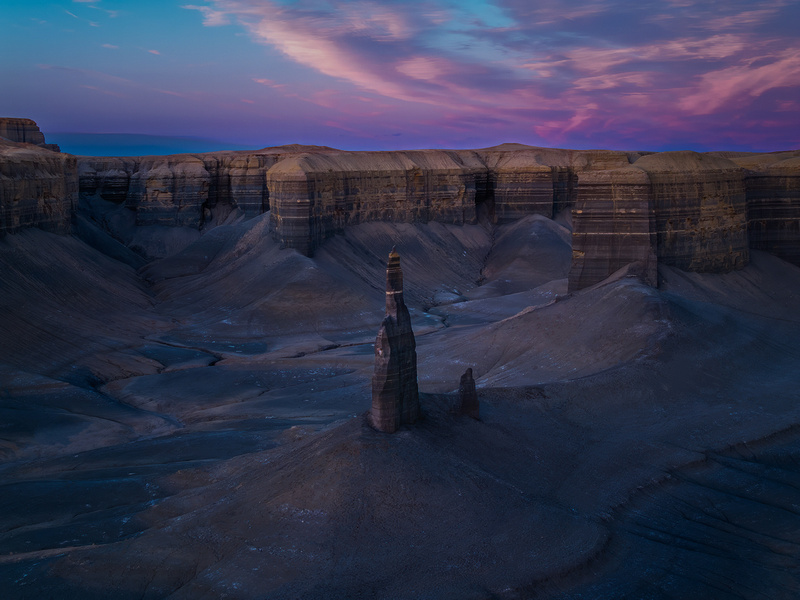Welcome to the landscape photography blog by Chuck Derus. Thanks for looking and for your comments!
The Journey


Sometimes, it’s only a few steps from the car. A great photograph can be that close. But other locations require a calculation about your hiking prowess.
Most landscape photographers hump a 30-pound backpack full of gear. And I’m not getting any younger. Uphill hikes at elevation can be difficult.
Despite the challenges, hiking to a location is part of the fun. It’s a wonderful time to enjoy being in the wilderness. Occasionally, it’s reassurance that I don’t need a cardiac screening test.
Last October, I joined friends and fellow photographers Steve Horne and Scott Fuller to explore the Southwest. One of our stops was Zion National Park.
I talked about icons in the previous Friday Photo. Canyon Overlook in Zion is one of them. It’s a gateway to one of the most magnificent views in the park.
The Canyon Overlook trail isn’t very long or challenging. It’s just one mile with an elevation gain of only 163 feet. But it offers a breathtaking view.
The trail starts with a set of stairs where most of the elevation gain occurs. From there, it’s relatively easy the rest of the way. You are walking along and below beautiful sandstone walls. While there are sheer drop-offs, many have guardrails.
The trail ultimately emerges onto a hilltop covered with hoodoos (mushroom shaped rocks). It then weaves across the sandstone slickrock and between pinyon pines to reach Canyon Overlook.
East Temple looms to the north, while to the west spreads a panorama highlighted by Bridge Mountain, the West Temple, the Towers of the Virgin and the Streaked Wall.
The Shot
Once there, it was a matter of finding a composition and waiting for the sunrise. The guardrail-protected overlook had a nice view, but we kept exploring. Treading carefully, we went off trail and each of us found slightly better compositions near the edge of the cliff.
Just before dawn, the clouds suffused the landscape with beautiful pinks. Taking our pictures, we packed up for the return trip. On the way, we were delighted to spot a group of desert bighorn sheep, recently reintroduced to Zion.
Thanks for looking,
Chuck Derus
Icons


Some photographers love them, and others avoid them like the plague. There’s probably a mix of emotions in most photographers.
What camera-toting individual could visit Yosemite National Park without going to Tunnel View? Or go to the Grand Tetons without seeking out the Mormon Barn Row?
Icons are icons because they are majestic locations. The views are breathtaking, they are easy to access, and composition is self-evident. But images of them are a dime a dozen.
I wonder if photographers secretly hope for a unique version. With the right light and weather conditions, there’s always a chance for a new and distinctive take on a familiar classic.
But most of the time, if we’re lucky, we leave with something that’s close to what others have accomplished.
Ansel Adams was without peer as a landscape photographer. He defined the genre for those that followed.
My introduction to him was via The Ansel Adams Guide series by John P. Schaeffer. Adams’ image, Tetons and the Snake River, is the defining image of this iconic location.


Tetons and the Snake River by Ansel Adams
The Shot
I was photographing fall color in Grand Tetons National Park last September. The urge to take out my camera at the Snake River overlook where Ansel Adams took his defining 1942 image was overwhelming.
Eighty-two years later, the view was quite different. The trees had grown obscuring the picturesque S-curve leading to the mountains. But part of the river and the magnificent mountains were just as visible.
My image was nothing remarkable, but satisfying, nevertheless.
Thanks for looking,
Chuck Derus
The Right Light


“In the right light, at the right time, everything is extraordinary.”
Aaron Rose
Windy, rainy, and cold. It was a miserable morning. Our anchored boat was rocking even in the lee of a small cove. Photography seemed out of the question.
I was over 100 miles from Puerto Natales, deep within the secluded waterways of Chile’s Kawésqar National Park. The park is one of the largest in the world. Situated within the Strait of Magellan, it’s a stunning sanctuary in the remote and untouched western Patagonian archipelago.
And Kawésqar is just one of 17 connected national parks in Southern Chile. All 17 comprise the unbroken 1,700-mile Tompkins Conservation’s Route of Parks. The Route offers an unparalleled glimpse into the region's wild beauty, showcasing diverse landscapes, ecosystems, and wildlife.


I was aboard the Explorador, operated by Patagonian Fjords Expeditions. Here’s our boat on a much nicer day near the Bernal Glacier.


It’s an ideal platform for exploration and photography. The deck afforded a 360-degree view of the beauty around us as we motored through the fjords.


When we weren’t on deck, we spent our time in the enclosed common area. It offered protection from the elements when the weather wasn’t cooperative.


I spent a minimum of time in my berth, shared with friend and fellow photographer Jon Christofersen. It was tight, and I felt like a piece of bread in a toaster when I slid into my upper bunk.


The Shot
Sometimes it only takes a sliver of sunshine to transform a morning and a photograph. Spotting a small break in the clouds to the east, our intrepid group of photographers quickly donned rubber boots, rain gear, and life preservers for the rainy, rocky ride in a Zodiac to the opposite shore.
Once ashore, we were rewarded by a rainbow! A tiny, transient opening in the clouds to the east had recast our morning.
I hastily set up my camera on a tripod less than a foot above the water. My goal was to capture a breaking wave with a long enough shutter speed to slightly blur the water but still leave bits of spray sharp. My lens cloth was put to good use constantly wiping rain drops and salt spray off my lens.
The rainbow disappeared quickly. Out of multiple attempts, one of my first turned out to be the best. The streaking foam leading to the wave in the foreground moved my eye to the mountains, the rainbow, and the blue sky in the background.
The right light, at the right time, had indeed made the morning extraordinary.
Thanks for looking,
Chuck Derus
Long Dong Silver


Is it Middle Earth? Are we on the set of Lord of the Rings? Where are these rock spires that majestically arise out of nowhere?
There’re actually near Hanksville, Utah. Hidden between towering cliffs, these twin black spires jut dramatically up and out of the ground. They were once part of an unbroken layer of sand and rock surrounded by cliffs.
But millions of years of erosion created a natural amphitheater. And for unknown reasons, only a lone pair of stoic shale spires remains in the middle.
An Unusual Name
This strange and fascinating formation goes by many names. A few refer to it as The Spire or The Needle. But it’s best known as Long Dong Silver.
That’s the stage name of retired British porn star Daniel Arthur Mead. His moniker was inspired by a play on words of the fictional Treasure Island character Long John Silver.
He appeared in several pornographic movies in the UK and US during the late 1970s and early 1980s. The actor reached a new audience in the wake of allegations of sexual harassment during the Clarence Thomas Supreme Court nomination in the US Senate in 1991. Anita Hill alleged that Thomas mentioned to her that he was a viewer of Long Dong Silver's films.
The Shot
Last October 28 I was in Hanksville, Utah with friends Steve Horne and Scott Fuller. We decided to visit and attempt to photograph this spellbinding formation.
The location isn’t marked. You must drive to GPS coordinates on the highway and then follow an unmarked dirt road for about a mile. After parking there, it’s about a 1.5-mile hike until you spot the spires.
I almost turned back. There was nothing notable for over a mile. It isn’t until the last few hundred yards that the formation came into view.
We did our best to take an interesting photograph. Nothing seemed to work. Out of curiosity, I took out my drone and circled the formation.
What a difference! As the sun set, I discovered this composition. I enjoyed how the spires seemed to line up with the setting sun.
Because there was sufficient battery power remaining, I kept flying. After the sun set, a view in the opposite direction caught the last light on the clouds.


Thanks for looking,
Chuck Derus
Animal Portraits


Up close and personal. The word portrait evokes a frame-filling face or full body shot of the species. Who would travel to Africa’s Serengeti without longing to capture a viewfinder-filling image of a zebra, for example?
The usual goal of an animal portrait is to reveal an adorable expression, capture a defining behavior, or to showcase a majestic coat of fur or colorful feathers. Ideally, only the animal is in focus with the background blurred. This way, the subject stands out with no distractions.
The photographer’s lens of choice is a big telephoto lens. It does a superb job of filling the frame and blurring the background.
But there is another kind of portrait. An environmental portrait is a landscape image with an animal included. Using a normal or short telephoto lens allows the photographer to show off the animal in its domain. The focus is about storytelling rather than documentation.
Wildlife Photos?
If you follow the Friday Photo, you know that if it moves, I don’t usually photograph it. But there are exceptions.
Last April in Patagonia, we had the opportunity to experience some of the wildlife. The South American gray fox, the Patagonian mara (rabbit), the crested cara cara, and the Andean condor all made appearances.
But the most common critter was the guanaco (ghwuah-NAH-koh). It’s a camelid native to South America. You might be more familiar with its domesticated relative, the llama.
Like all camels, Guanacos are herbivores. They graze on grasses, shrubs, herbs, lichens, fungi, cacti, and flowers.
Guanacos live in herds composed of females, their young, and a single dominant male. Around one year of age, young males are expelled from the herd.
The reproductive groups tend to remain small, often containing no more than 10 adults. Bachelor herds may contain as many as 50 males. Though typically mild-mannered, guanacos often spit up to six feet when threatened.
Preyed upon by puma (aka mountain lions), they can run at 35 mph per hour, even over steep and rocky terrain. They are also excellent swimmers. A guanaco's typical lifespan is 20 to 25 years.
The Shot
None of us on the photo tour were wildlife photographers. However, another reason to capture an image of the Andes mountains was appealing. While the mid-afternoon light was terrible for a pure landscape image, it could create magical backlighting of an animal.
As we cruised the road, we kept an eye out for guanaco. After a short drive, we spotted a herd and exited the car. We slowly walked towards them to nudge them into position.
It required 30 minutes or so, but finally we had a solitary guanaco outlined with a glowing halo of fur with the towering Andes in the distance. I hoped this photograph would tell their story.
Thanks for looking,
Chuck Derus